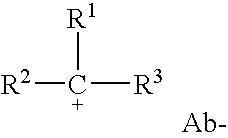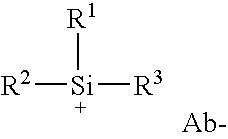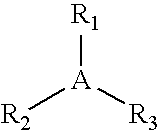Peroxide curable rubber compound containing high multiolefin halobutyl ionomers
- Summary
- Abstract
- Description
- Claims
- Application Information
AI Technical Summary
Benefits of technology
Problems solved by technology
Method used
Image
Examples
example 1
Preparation of High Isoprene BIIR
[0068]110 mL of elemental bromine was added to a solution of 7 kg of 6.5 mol % of 1,4 high isoprene butyl polymer prepared according to Example 2 of CA 2,418,884 in 31.8 kg of hexanes and 2.31 kg of water in a 95 L reactor with rapid agitation. After 5 minutes, the reaction was terminated via the addition of a caustic solution of 76 g of NaOH in 1 L of water. Following an additional 10 minutes of agitation, a stabilizer solution of 21.0 g of epoxidized soya-bean oil and 0.25 g of Irganox® 1076 in 500 mL of hexanes and one of 47.0 g of epoxidized soya-bean oil and 105 g of calcium stearate in 500 mL of hexanes was added to the reaction mixture. After an additional 1 h of agitation, the high multiolefin butyl polymer was isolated by steam coagulation. The final material was dried to a constant weight with the use of a two roll 10″×20″ mill operating at 100° C. The microstructure of the resulting material is presented in Table 1.
example 2
Preparation of High Isoprene IIR Lonomer
[0069]48 g of Example 1 and 4.7 g (3 molar equivalents based on allylic bromide content of Example 1) of triphenylphosphine were added to a Brabender internal mixer (Capacity 75 g) operating at 100° C. and a rotor speed of 60 RPM. Mixing was carried out for a total of 60 minutes. Analysis of the final product by 1HNMR confirmed the complete conversion of all the allylic bromide sites of Example 1 to the corresponding ionomeric species. The resulting material was also found to possess ca. 4.2 mol % of 1,4-isoprene.
example 3
Preparation of High IP IIR Cured Article (Comparative)
[0070]40 g of high IP IIR which possessed a 1,4-IP content of 4.2 mol % (prepared according to Example 1 of CA 2,418,884 was introduced into a Brabender miniature internal mixer (Capacity=75 g) operating at 30° C. with a rotor speed of 60 RPM After 1 minute of mixing, 20 g of IRB #7 was introduced into the mixture. Following an additional 2 minutes of mixing, 0.8 g of HVA #2 was added into the mixture. After 1 minute, 1.6 g of DiCup 40C was added into the internal mixer. The resulting mixture was allowed to blend for an additional 2 minutes. The resulting formulation was cured and the tensile properties were determined as described above. These results are tabulated in Table 2.
PUM
| Property | Measurement | Unit |
|---|---|---|
| Fraction | aaaaa | aaaaa |
| Fraction | aaaaa | aaaaa |
| Fraction | aaaaa | aaaaa |
Abstract
Description
Claims
Application Information
 Login to View More
Login to View More - R&D
- Intellectual Property
- Life Sciences
- Materials
- Tech Scout
- Unparalleled Data Quality
- Higher Quality Content
- 60% Fewer Hallucinations
Browse by: Latest US Patents, China's latest patents, Technical Efficacy Thesaurus, Application Domain, Technology Topic, Popular Technical Reports.
© 2025 PatSnap. All rights reserved.Legal|Privacy policy|Modern Slavery Act Transparency Statement|Sitemap|About US| Contact US: help@patsnap.com



